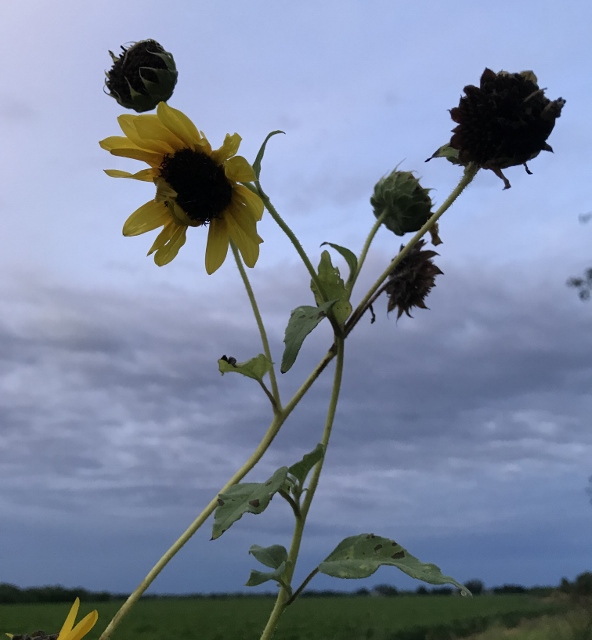
Garden chores, like watering a garden, are excellent opportunities for mind-drifts. Thoughts are all over the place, but these mental leaps and bounds often provide impressive insight — especially when pen and paper is reached before the elusive thoughts dissipate.
On a dreadfully hot June morning — before news of last week’s forthcoming Valley storms — a fellow writer, Texas Master Naturalist, poetess, friend and fellow Kansas-born Texan e-mailed me with what went through her head while she was desperately trying to keep her pollinator garden hydrated.
“Sunflowers are survivors,” she wrote. “They can take the heat, the dry weather and still, readily bloom and reseed. They bloom much of the year in the Valley, even when other plants have given up. And it’s the Kansas state flower.” Did I think her wandering thoughts would be worthy of a blog?
Yes, of course! Thank you, 2nd Vice
Common Sunflower, Mirasol, Helianthus annuus. Page 105, Richardson/King, “Plants of Deep South Texas.” Mirasol translates as, sunflower.
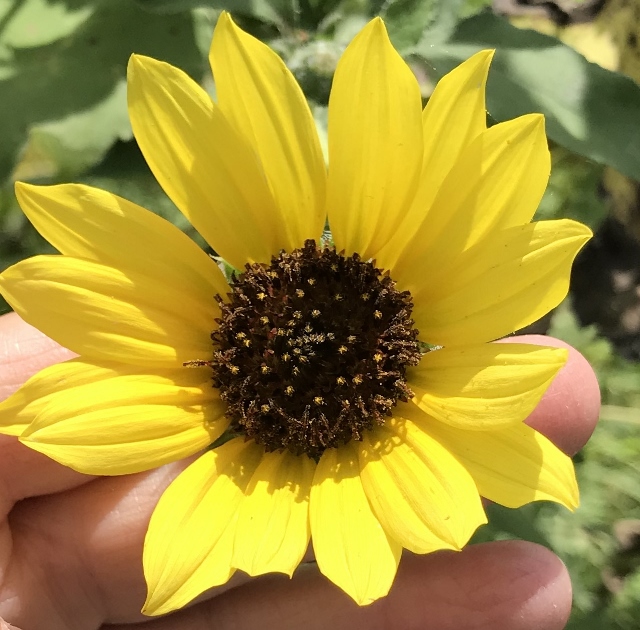
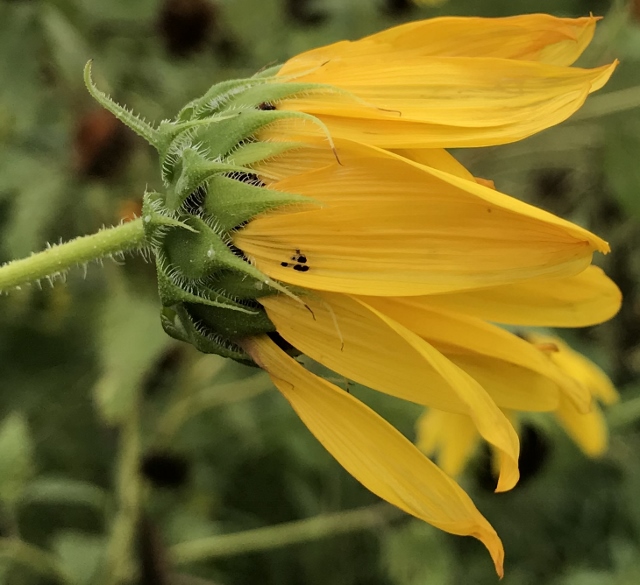
Sunflowers are nectar plants for many butterflies and host plants for painted lady, American lady, bordered patch and silvery checkerspot butterflies.
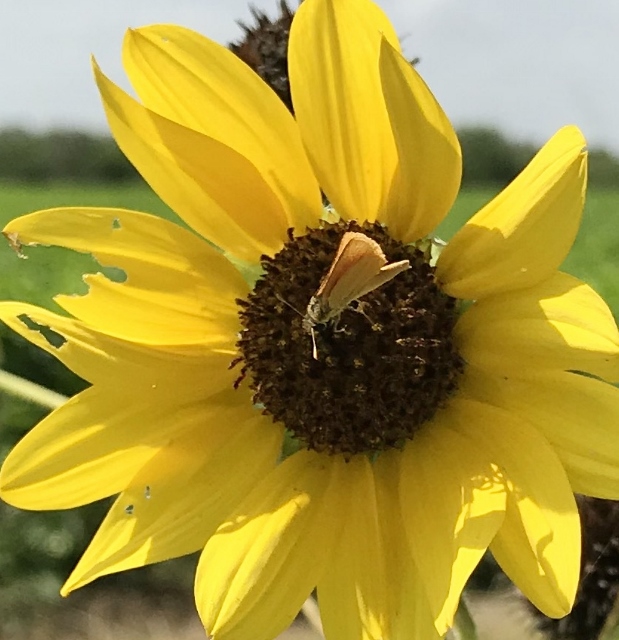
Sunflowers are nectar and pollen plants for bees. One website describes them as a “nectar and pollen mother lode for their pollinators . . . . Sunflowers’ compositae design has each flower head’s central disc that contains many smaller tubular disc flowers, each with its own supply of nectar and pollen.”
The showy yellow outer ray petals of the sunflower help attract the bees and then they go from flower to flower in the disc, getting covered with pollen and then on to other sunflowers. https://homeguides.sfgate.com/bees-pollinate-sunflowers-65431.html
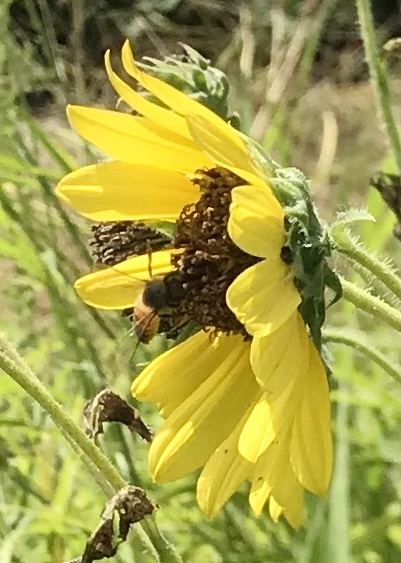
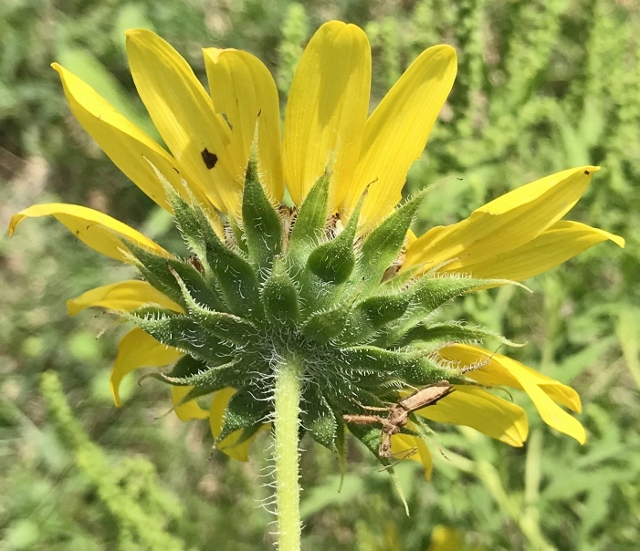
Sunflowers make good homes for spiders and certainly a substantial platform for hooking spider webs from stem to stem.
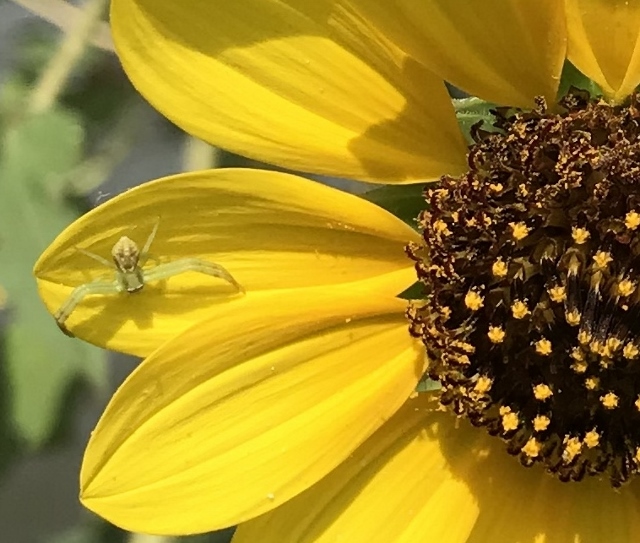
And of course the finished product — the sunflower seeds — provide food for birds and bugs. The lesser goldfinch is a permanent resident in my friend’s Pharr yard where she never ceases to delight in watching the small bird hang on native sunflower seed heads, devouring the seeds.
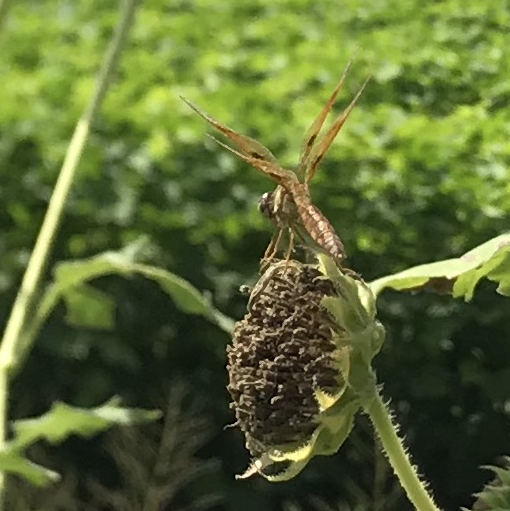
But wait, the sunflower’s usefulness doesn’t stop with seed production.
Consider leaving the dead stalks to provide homes for some species of native bees, she recommends. If that’s too unsightly, cut them off and stack at the back of a garden or near a compost pile.
Bees that are above-ground nesters use hollow stems of pithy-stemmed plants in which to nest.
Since sunflowers are long-lived, their root base is tremendously helpful in holding the soil during our windy summers. Even dead stalks will continue to hold the soil. Mowed down and mulched, they continue to add nutrients and microorganisms to the soil long after they’ve fed their last butterfly.
With all those ideas just while tending an early morning chore, I thought I’d do a little research.
Sunflower fun facts
- The Guinness world record for the tallest sunflower is 25 feet 5 ½ inches and was grown by M. Heijims in Oirschot, Netherlands in 1986. He held that record until 2014 when a Hans-Peter Schiffer grew one that reached 30 feet and one inch.
- Sunflowers are one of the fastest growing plants.
- The sunflower is native to the Americas and was used extensively by Native American Indians for food, as oil, in bread, medical ointments, dyes and body paints.
- Sunflowers were introduced from the Americas into Europe in 1510 by the Spanish and now are grown on all continents except Antarctica
- “Helianthus” is the scientific name – Helia for sun, Anthus for flower.
- Sunflowers are the symbol of faith, loyalty and adoration.
- Sunflower stems were the original filler material for Personal Floatation Devices/Life Jackets.
- Sunflowers are one of the official flowers of the Leo in the Zodiac.
Everyone knows that sunflowers follow the sun, right? They have motor cells in the flower head which move the head so it faces the sun. Heliotropism is the term for this plant characteristic of moving its head. Sunflower “faces” or follows the sun east to west through the sky and returns at night to face the east, ready for the morning sun. Heliotropism only occurs during early stages before the flowers form seeds. A mature flower usually points in a fixed easterly direction.
On another fun note:
Question: The seeds in the center of the sunflower are aligned in harmony with what famous equation?
Answer: The Fibonacci Sequence
I know one Texas Master Naturalist chapter member maths expert who probably knew the answer! Here’s the skinny:
“The flowers within a sunflower head are clustered in a spiral pattern whereby each floret is oriented towards the next by the golden angle of 137.5°. This produces a pattern of interconnecting spirals. The number of left and right spirals are consecutive Fibonacci numbers. Normally there are 34 spirals in one direction and 55 in the other. Very large sunflowers can have 89 in one direction and 144 in the other.” http://www.sciencekids.co.nz/sciencefacts/plants/sunflowers.html
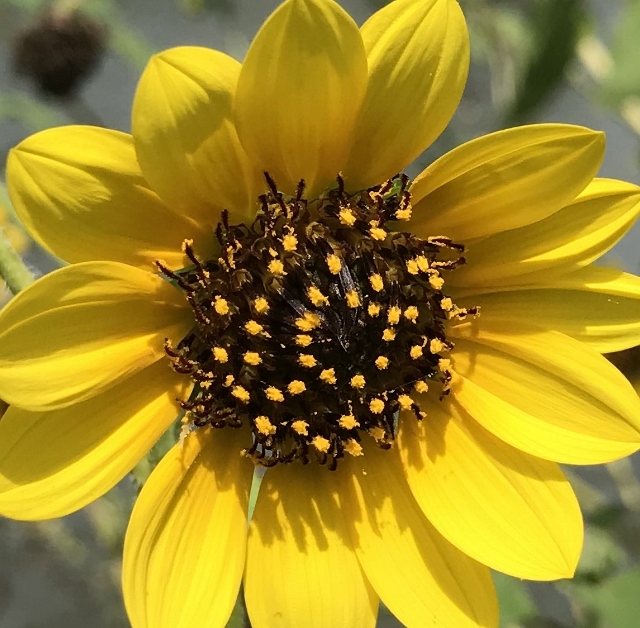
After you’ve counted the seeds in your sunflower heads and then left the heads hanging on the dried up stalks to feed birds, bugs and possibly squirrels, don’t toss out those empty sunflower heads.
Yes, really! Give this a try — they can be used as a disposable scrubbing pad for tough jobs like cleaning your tools before you put them up. Ok, that’s probably a bit too re-purpose-esque. It was in a site about giant, cultivated sunflowers, not our smaller-headed Helianthus annuus — none the less, if you try it, please report in!
Regardless what comes between a sunflower’s first leaves pushing out of the soil through its grand applications in the native dimension and on to its silent demise, in the end, the plants are excellent fodder for the compost pile. Wear gloves — the live and dead stalk is covered in very fine, itch-producing hairs. Also, decomposition is best when the debris is chopped up.
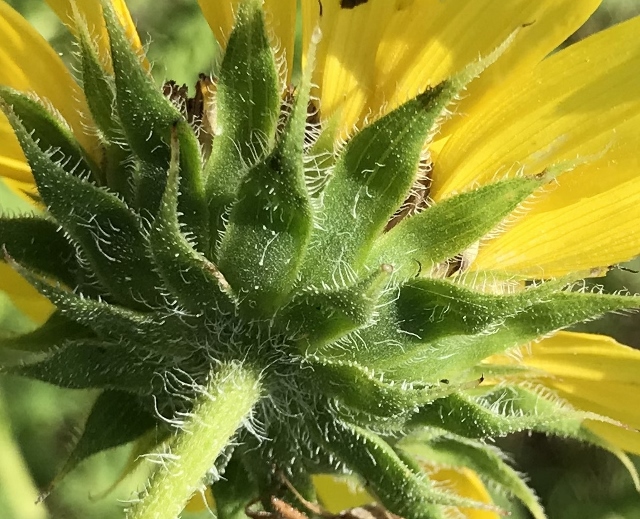
If all this information hasn’t enamored you to sunflowers in all their splendid glory, consider this: Sunflowers naturally decontaminate soil. They can soak up hazardous materials such as uranium, lead, and even arsenic, Elizabeth also imparted in her e-mail to me.
That led to more research where I found this spectacular information:
Sunflowers have been planted to help soak up nuclear radiation. “Millions were planted after the devastating tsunami destroyed reactors in the Fukushima nuclear power plant in Japan.”
https://gardencollage.com/change/sustainability/scientists-using-sunflowers-clean-nuclear-radiation/ “Scientists are using sunflowers to clean up nuclear radiation,” by Molly Beauchemin.
Sunflower Strewn Fencelines
By Elizabeth Perdomo
Sunflower strewn fencelines stand,
yellow blossomed, arms raised
high as blue sky morning,
brown centers stand tall,
golden with promised
bees, butterflies
& high bird
flight.
18 July 2016 – Hwy 285 between Falfurrias & Rivera, Texas
References:
https://www.spinfold.com/
https://cals.arizona.edu/
https://www.goodhouseheeping.com/
https://shesaidsunflower.com/
https://www.inaturalist.org/
